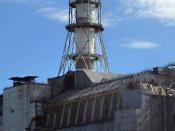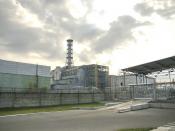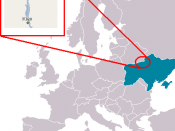What happened at the Chernobyl Nuclear Power Plant, on April 26, 1986, was the biggest nuclear accident in nuclear history. It caused thousands of deaths through radiation and the sickness induced by it. Thirty three of those deaths were almost immediate, and the rest followed in the years after.
All of these deaths were caused by the explosion and following fire of the Number Four Reactor of the type RBMK (meaning Power Boiling Reactor) (Read, P. VII). It was a reactor manned by incompetent operators, untrained to handle it properly, and it held inside it 185 tons of uranium 235 (Read, P. 32). It went out of control and erupted in a steam explosion. That, in turn, caused a chemical explosion, which, in blowing off the reactor's roof, released tons of radioactive particles into the world. And, it all happened because of a careless experiment.
The disaster at Chernobyl (at left) cannot even be called an accident.
It was the result of an experiment to see if the plant could successfully close down during a blackout. And, this experiment became a catastrophe when the reactor went out of control, overheated, and blew up.
This did not happen without human intervention. Director Bryukhanov of the Chernobyl Plant and Chief Engineer Fomin (both at left) decided that the experiment would be a 'pure' (Cheney, 1993) one. That meant that it was to simulate, as much as it could, an actual emergency situation. So, the emergency systems of the Plant were disconnected, along with the diesel generators, which would supply power to the reactor if the normal source was cut off.
The experiment was launched at 11:00 p.m., on April 25. The power level to the reactor was lowered. Because of the low power the fuel of the reactor began to be...


